Books
Books
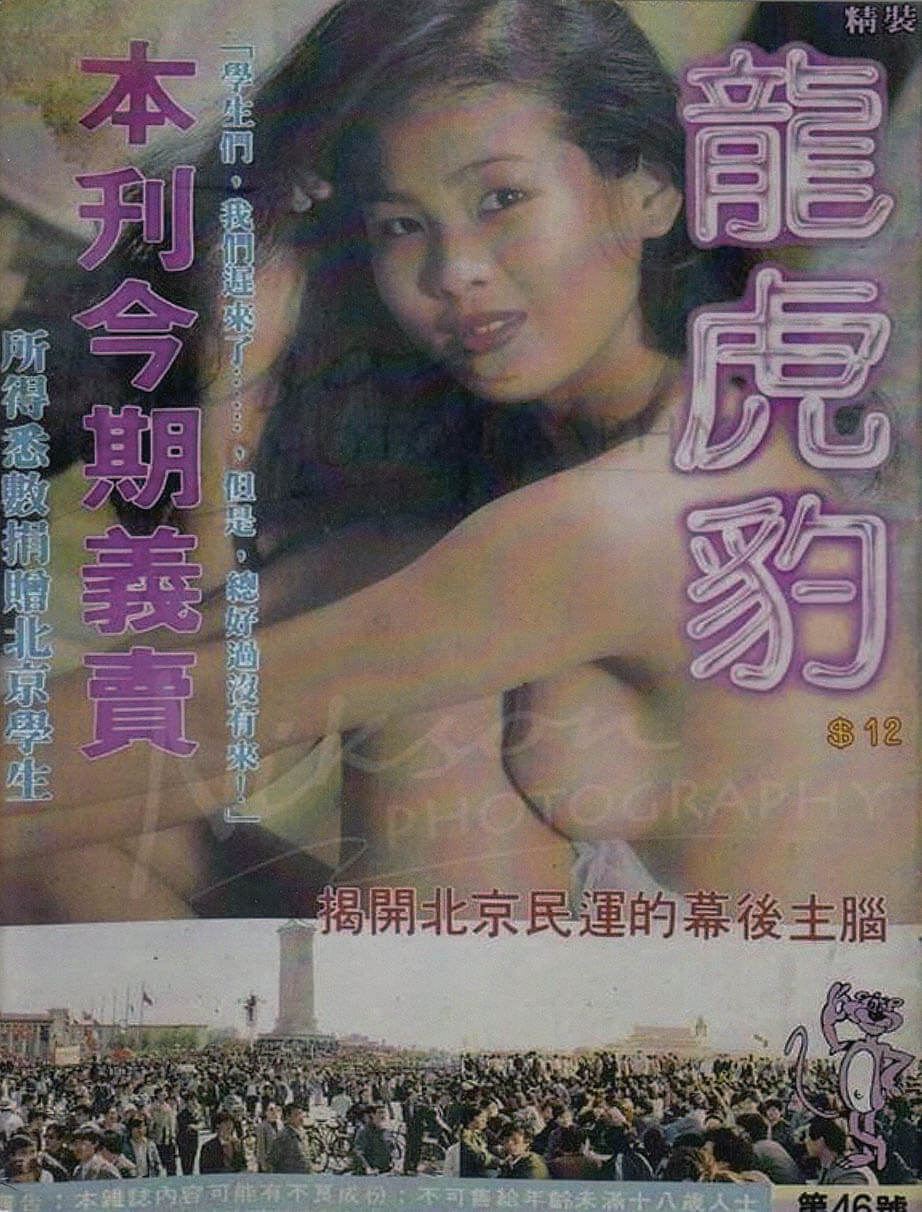
(Salty Wet)
咸濕 (Salty Wet) - an anti-travelogue essay on distance and desire within and without Hong Kong
“There is no Hong Kong anymore.” These four words have been on the lips of my colleagues, friends and family. Even if you have never been, every Chinatown is a facsimile of Hong Kong. The city’s specter also lives in pop culture, movies and cantopop and video games, and in these projections, we live its simulacrum. In history, dead cities have their morbid enigma and mythology from Pompeii to Rome. But if I could find coherence in living through political decay, outside of the frameworks of news journalism or historiography, then perhaps I would be able to find a more human way to mourn Hong Kong."
T▇▇ 謝▇ is an independent film producer based between Hong Kong and New York and the founder of Speculative Place. She was the Executive Producer of Adam Khalil and Bayley Sweitzer’s feature debut film Empty Metal, and the forthcoming documentary film, Ancestors in the Archives, directed by Adam and Zack Khalil. 謝 is pronounced SHä (as in Shanghainese).
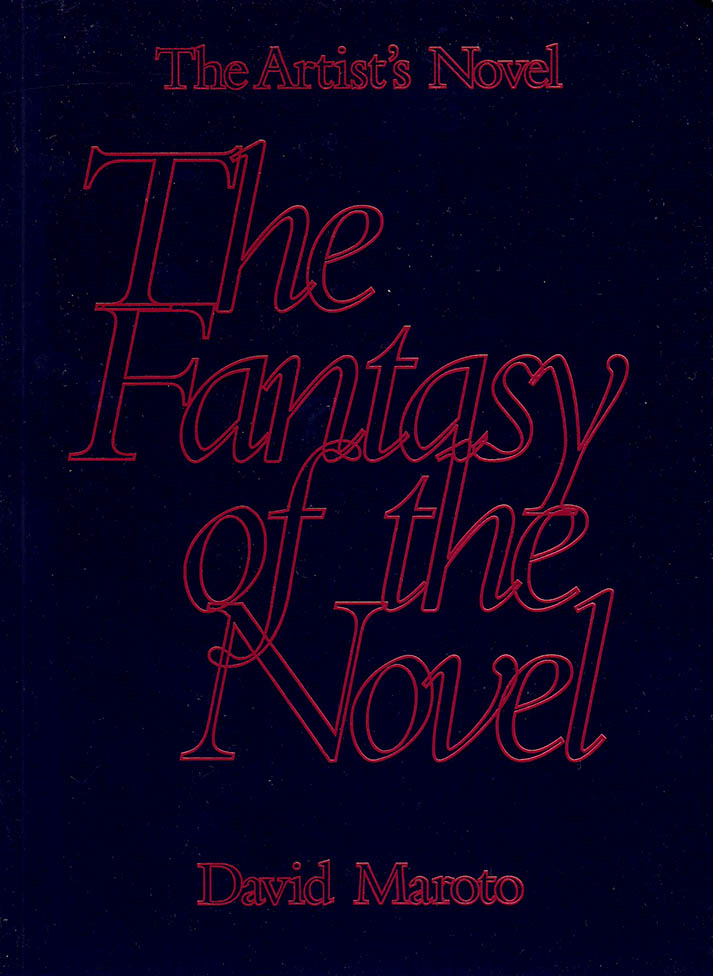
The Fantasy of the Novel
Second volume of a publication dedicated to the artist's novel, this metafiction follows a detective investigating the conditions of production of a novel within an artistic framework.
Why do artists write novels? What impact does the artist's novel have on the visual arts? How should such a novel be experienced? In recent years, there has been a proliferation of visual artists who create novels as part of their broader art practice. They do so in order to address artistic issues by means of novelistic devices, favoring a sort of art predicated on process and subjectivity, introducing notions such as fiction, narrative, and imagination. In this sense, it is possible to see the novel as a new medium in the visual arts; yet very little is known about it. This two-volume publication is the first to explore in depth the subject of the artist's novel.
The Fantasy of the Novel, is a research project in the form of a novel; it examines the process of creating an artist's novel derived from five episodic performances and an exhibition. The creative process was affected by the circumstances of production, including intersubjective relationships usually invisible to audiences. The protagonist assumes the role of a detective who tries to understand the conditions under which an artist decides to write, and how this writing is possible within an artistic setting.
David Maroto (born 1976, lives and works in Rotterdam) is a Spanish visual artist, researcher, writer, and curator. He is the co-curator of The Book Lovers, a research project on the artist's novel, together with Joanna Zielińska.
Published 2020

The Other Citizen
Drawing upon traditions of socially engaged poetics, Brandon LaBelle's The Other Citizen presents narratives of contemporary crisis and exclusionary politics—from American teenagers in the maze of neoliberal privatization to those caught between borders of nation-states—outlining the force of a planetary citizenry.
Brandon LaBelle is a musician, artist, writer, theorist, curator and editor (founder of Errant Bodies). His work is based on performance, sound installation, recording and use of found sounds. LaBelle reflects fluently on his artistic practice, drawing attention to the social dimensions of listening and manner in which sounds, in multiple variations, play upon public spaces, and drawing connections across media and incorporate video, as well as architectural and sculptural vocabularies into an expanded field that embraces rhetorical and spatial challenges.
Published September 2020.

The Nomadic Listener
Based on the author's artistic research on migration, contemporary urban experience, and sonic alienation, The Nomadic Listener is composed of a series of texts stemming from psychogeographic explorations of contemporary cities, including Copenhagen, Berlin, Kolkata, Vienna, Delhi, Hong Kong, Mumbai, and New York, among others.
Each text is an act of listening, where the author records his surrounding environment and attunes to the sonic fluctuations of movement and the passing of events. What surfaces is a collection of meditations on the occurrences of life movingly interwoven with memories, associations, desires and reflections. As readers we are brought into a tender map of contemporary urban experience, and the often lonely, surprising, and random interactions found in traveling. The Nomadic Listener includes parallel drawings based on the original audio recordings, and appear as ghostly renderings of the corresponding experiences. The recordings are published by Gruenrekorder and accessed through a QR code included in the book.
Budhaditya Chattopadhyay is a contemporary artist, researcher, writer and theorist. Incorporating diverse media, such as sound and moving image, Chattopadhyay produces works for large-scale installation and live performance addressing urgent issues such as the climate crisis, human intervention in the environment and ecology, migration, race, and decolonization.
published September 2020.
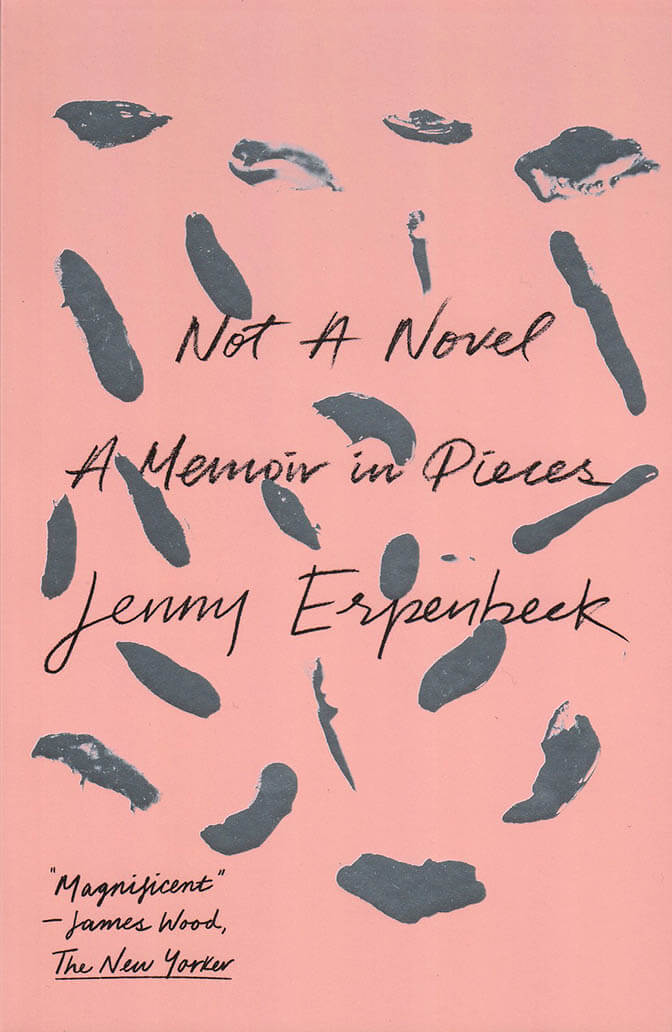
Not A Novel
Jenny Erpenbeck's highly acclaimed novel Go, Went, Gone was a New York Times notable book and launched one of Germany's most admired writers into the American spotlight. In the New Yorker, James Wood wrote: "When Erpenbeck wins the Nobel Prize in a few years, I suspect that this novel will be cited."
On the heels of this literary breakthrough comes Not a Novel, a book of personal, profound, often humorous meditations and reflections. Erpenbeck writes, "With this collection of texts, I am looking back for the first time at many years of my life, at the thoughts that filled my life from day to day."
Starting with her childhood days in East Berlin ("I start with my life as a schoolgirl ... my own conscious life begins at the same time as the socialist life of Leipziger Strasse"), Not a Novel provides a glimpse of growing up in the GDR and of what it was like to be twenty-two when the wall collapsed; it takes us through Erpenbeck's early adult years, working in a bakery after immersing herself in the worlds of music, theater, and opera, and ultimately discovering her path as a writer.
There are lively essays about her literary influences (Thomas Bernhard, the Brothers Grimm, Kafka, and Thomas Mann), unforgettable reflections on the forces at work in her novels (including history, silence, and time), and scathing commentaries on the dire situation of America and Europe today. "Why do we still hear laments for the Germans who died attempting to flee over the wall, but almost none for the countless refugees who have drowned in the Mediterranean in recent years, turning the sea into a giant grave?" With deep insight and warm intelligence, Jenny Erpenbeck provides us with a collection of unforgettable essays that take us into the heart and mind of "one of the finest and most exciting writers alive"
Published September 2020.
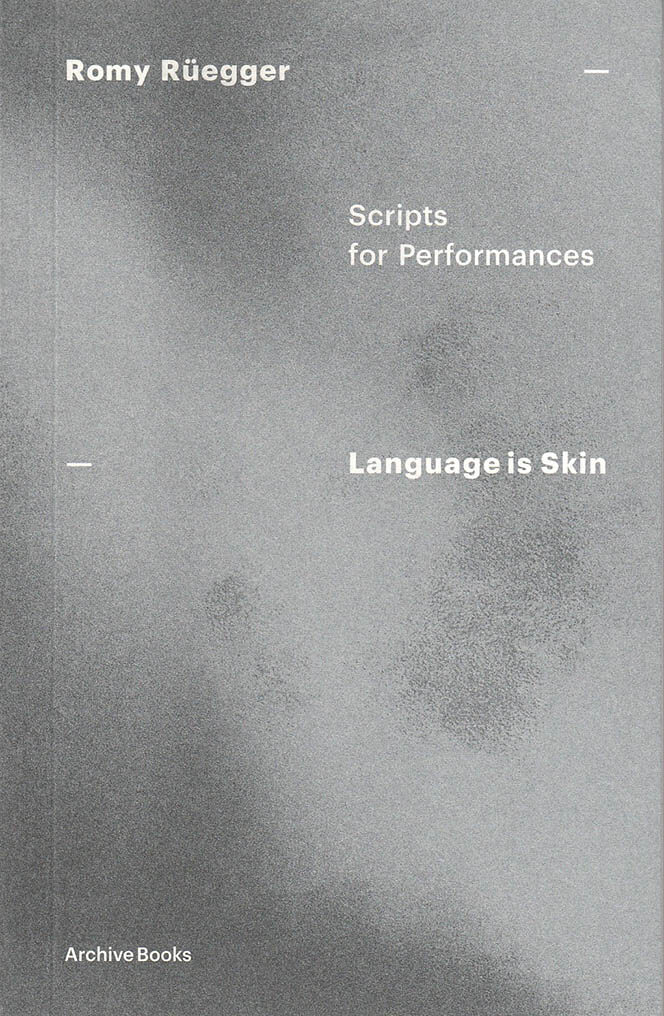
Language Is Skin: Scripts for Performances
The scripts of Romy Rüegger's performances: a constellation of texts, largely written to be spoken. The scripts as they are printed do not document the performances primarily. They are indications of spacial and temporal layering, juxtapositions of aesthetic and poetic elements and bodies. Overlapping every day observations with archival material, confronting, jumping.
Romy Rüegger (born 1983, lives and works in Zurich) is an artist and writer working with sound-based practices and shared listening. Her writings for performances, audio works and choreographed spaces draw on anti-racist and intersectional politics of language and memory. Recent performances, audio works and publication contributions include Synthetic Stream Plays (Kunsthalle Basel, 2018), Binary Codes as NO (Gasworks, London, 2018), “I am the Wall” (in: Grounds for Possible Music, Errant Bodies Press, Berlin, 2018), Reina llora*, Reads (Transmission Gallery, Glasgow, 2017), I am the Wall (Q-O2 / Performatik Festival, Brussels, 2017), History is Closed Today (Helmhaus, Zurich, 2017), J'ai everyday ma substance (in collaboration with Anna Frei, Künstlerhaus Büchsenhausen, Innsbruck, 2017).
Published 2018
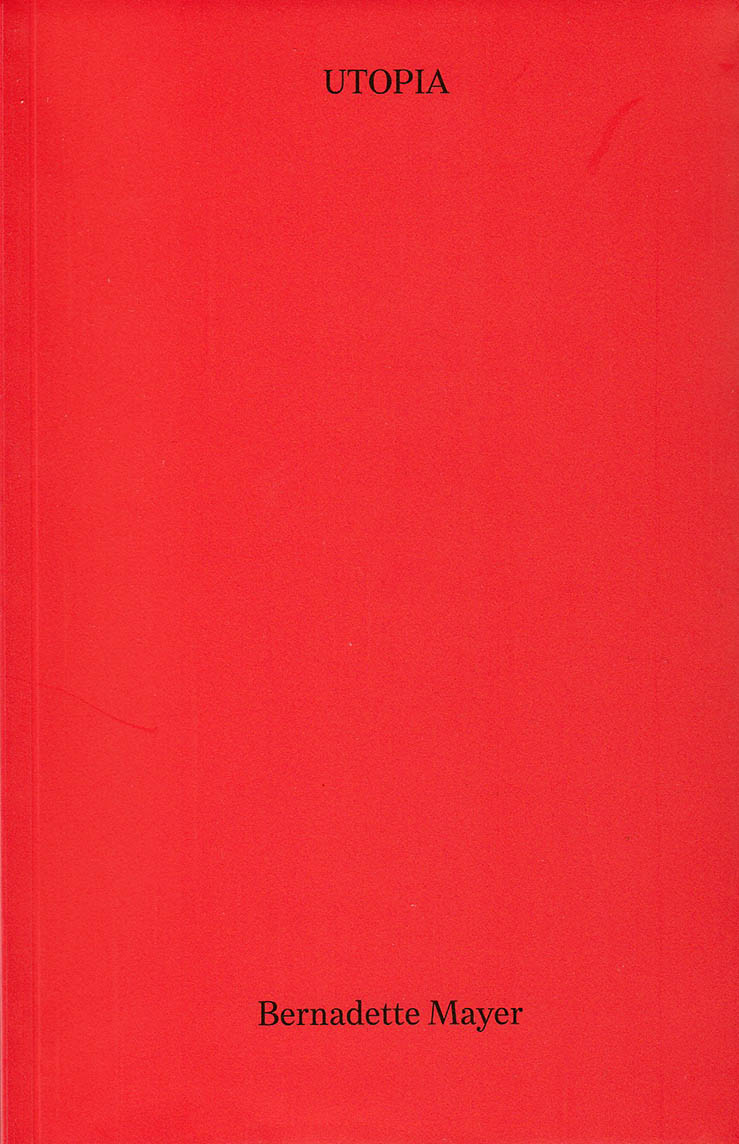
Utopia
A collection of texts defining utopia as a place existing only within the domain of language, Utopia gives a synthesis of historical utopias and a snapshot of the 1970-1980's poetic scene.
An avant-garde writer associated with the New York School of poets, Bernadette Mayer was born in 1945 in Brooklyn, New York, where she lives and works. From 1967 to 1969, she published the experimental newspaper 0 to 9 with artist Vito Acconci, which combined texts and works of writers and conceptual artists based on the use of language (Ted Berrigan, Clark Coolidge, Hannah Weiner, Aram Saroyan, Robert Smithson, Dan Graham, Morton Feldman or Sol LeWitt).
In 1967—along with Lewis Warsh—she founded the publishing house United Artists Books which published a number of influential writers such as Robert Creeley, Anne Waldman, Hannah Weiner, James Schuyler, Ted Berrigan and Alice Notley as well as Mayer's own books like 1978's The Golden books of Words or 1984's Utopia. Known for her innovative use of language, Mayer rose to prominence with the exhibition “Memory,” which combined photography and narration. During July 1971 Mayer took daily photographs and recorded her thoughts. These materials formed the basis for the exhibition, and for the eponymous book published in 1975. In 1980, Mayer became director of the Poetry Project at St. Mark's Church in New York where she also ran literary workshops. She also initiated the Poetry Project's Reading Series.
Mayer's composition methods such as chance operation, collage and cut-up identifies her as being close to the likes of John Cage, Jackson Mac Low or Frank O'Hara—central figures of the New York School—as well as more contemporary figures associated with the magazine L=A=N=G=U=A=G=E. Mayer's work is also influenced by modernist figures such as James Joyce, Gertrude Stein and the Dadaists or classical authors (Catullus).
French Edition.
Published in June 2016.
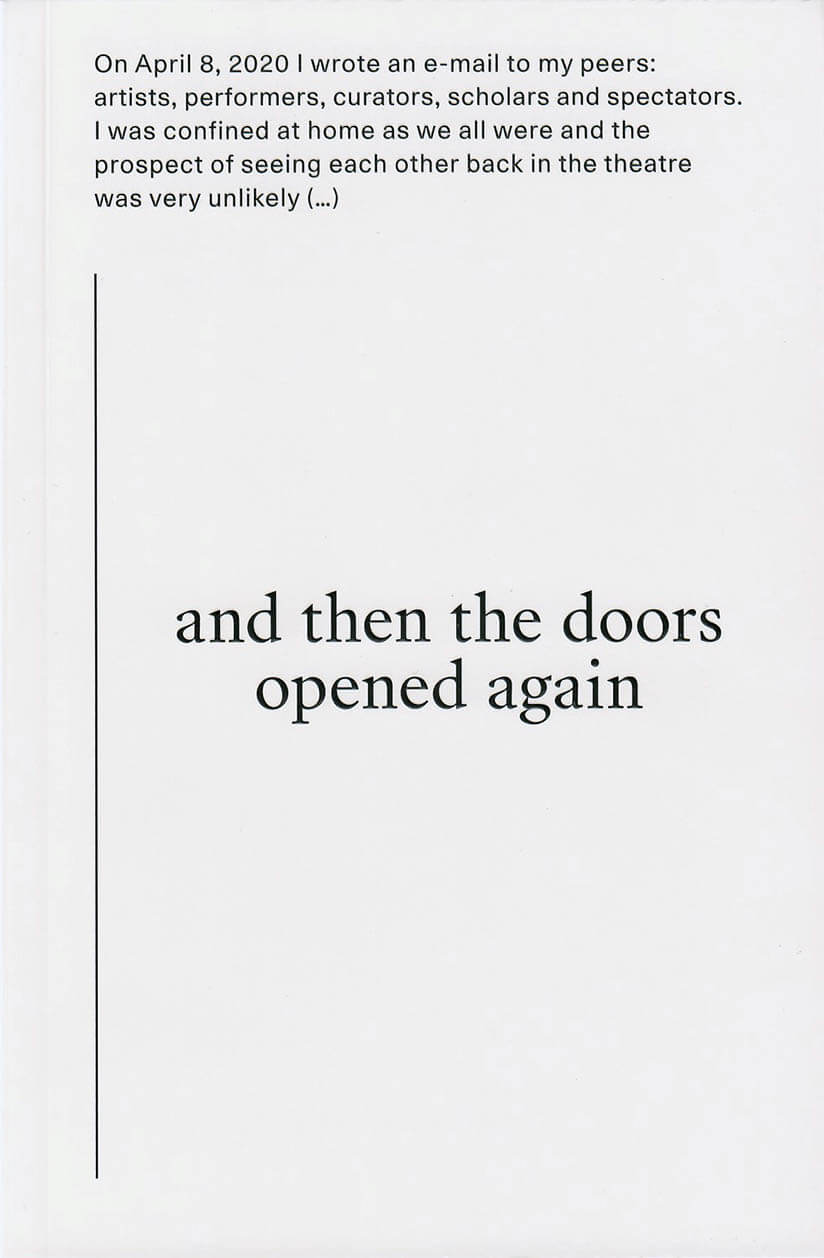
and then the doors opened again
Locked down at home during the first wave of Covid-19, David Weber-Krebs kept on thinking about the day when theatres would open their doors again. At that point, it was somehow difficult to even picture that moment.
On the 8th of April, 2020, in the middle of the lockdown, David sent an e-mail to his peers: artists, scholars, curators, and spectators belonging to different art communities. In this e-mail, there was a simple question: What will happen on your first theatre visit after the lockdown?
It was an invitation to imagine the future of theatre from this very specific moment when theatres were all closed and when it was not clear how and when and if they would open again.
With contributions by: Paula Almiron, Kristof van Baarle, Sven Age Birkeland, Antonia Baehr, Caroline Barneaud, Nicole Beutler, Maaike Bleeker, Julien Bruneau, Pieter De Buysser, Alondra Castellanos, Chloé Chignell, Amélie Coster, Jasper Delbecke, Zoë Demoustier, Wouter De Raeve, Charlotte De Somviele, Katja Dreyer, Jeroen Fabius, Silvia Fanti, Far, Nicolas Galeazzi, Emilie Gallier, Nada Gambier, Melih Gencboyaci, Konstantina Georgelou, Kristof van Gestel, Matthieu Goeury, Maximilian Haas, Ant Hampton, David Helbich, Marijke Hoogenboom, Rita Hofwijk, Breg Horemans, Asa Horvitz, Dolores Hulan, Mette Ingvartsen, Myriam Van Imschoot and Marcus Bergner (MM), Stefan Kaegi, Edyta Kozak, Bojana Kunst, Rudi Laermans, Sarah van Lamsweerde, Heike Langsdorf, Mylène Lauzon, André Lepecki, Kopano Maroga, Ivana Müller, Phoebe Osborne, Leonie Persyn, Julie Pfleiderer, Antoine Pickels, Amanda Piña, Jan-Philipp Possmann, Fransien van der Putt, Irena Radmanovic, Anna Rispoli, Martina Ruhsam, Jonas Rutgeerts, Nienke Scholts, Ula Sickle, Michael Simon, Karoline Skuseth, Lara Staal, Christel Stalpaert, Danae Theodoridou, Pankaj Tiwari, Vera Tussing, Marie Urban, Michiel Vandevelde, Hidde Aans Verkade, Mathilde Villeneuve, Georg Weinand, Stefanie Wenner, Siegmar Zacharias, Andros Zins-Browne.

on the future and the artist-run spaces
Artists, curators and writers describe their vision on the role of artist-run spaces for the future and discuss their own position in the world of art. The authors weigh in on the importance of artist-run spaces and reach out to anyone looking for alternative ways of thinking, working and living together.

Forms of Public Privacy
Forms of Public Privacy is part of the larger FORMAT 2019 exhibtion ‘Changing Attitudes’ in Z33, Hasselt. As a critique on the current urban trend to overpragram and overdesign Belgium cities, and Western cities in general, a reasearch is done into five cases of abandoned and un-maintained spaces in Brussels. In the exhibition a series of sculptural models show architectural elements of the investigated spaces that provide a certain spatial intimacy and public privacy. These models, together with photographs of Axel de Marteau and a publication, argue for the value of these abandoned and un-programmed spaces within an urban setting. Their informal programs such as hangout spots, living spaces and meetings spaces form a vital part of the social spaces and commons of our cities.
This is the publication to that research.
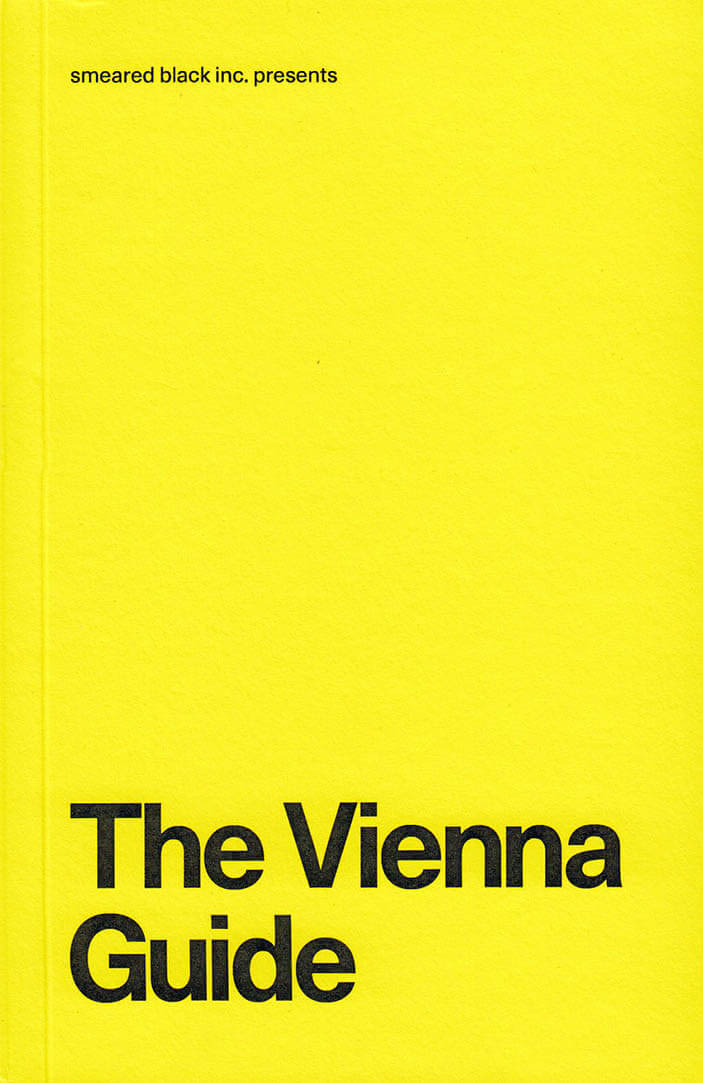
The Vienna Guide
The Vienna Guide is conceptually built upon ‘travel notes” compiled and edited on the occasion by artist Tony Cokes. Adopting the point of view of the flaneur, Cokes creates a speculative image of Vienna by appropriating and meshing non-art, historical figures, touristic clichés and club nights, all entwined in technological commentary. This distant gaze – Cokes hasn’t visited Vienna in the last 20 years – facilitates an aerial view of the complexities and unique traits that characterizes it. Commissioned by Attilia Fattori Franchini the Guide proposes to approach Vienna – and any urban site – as a discursive platform for future possibilities and identities.
The Vienna Guide by Tony Cokes comprises 3 stickers of video stills of Cokes’ videos Could you visit me in dreams? (2018), published in an edition of 150 + 25.

a queer anthology of healing
a queer anthology of healing is a subtle, devastating mix of cuteness and embarrassment, beauty and confession, magic tricks and pain. The artworks and writings in this collection suggest that healing can be achieved through revelation, invocation, observation and disclosure. It’s a much-needed gift right now. - Chris Kraus
with Clay AD, Harry Agius, Barney Ashton-Bullock, Bodie Bellamy, Jack Bigglestone, Nick Blackburn, Helen Cammock, Charity Coleman, Swithun Cooper, Paul Gabrielli, Evan Garza, Erica Gillingham, Daniel Givens, Pete Hammond, Benedict Hawkins, Georgie Henley, Lubaina Himid, Fanny Howe, Jasmine Johnson, G.B. Jones, Kevin Killian, Wayne Koestenbaum Nic Lachance Olivia Laing, Benedict Leader, Paul Lee, Mary Manning, Ben Miller, D. Mortimer, Monique Mouton, Annie Murrells, Chuck Nanney, David Nas, Isobel Neviazsky,Paul P. , Richard Porter,Peter Scalpello, Hyacinth Schuss, Ryan Skelton, Verity Spott, Edward Thomasson, Timothy Thornton, Declan Wiffen, Ian Wooldridge

Just Us (hardcover)
As everyday white supremacy becomes increasingly vocalized with no clear answers at hand, how best might we approach one another? Claudia Rankine, without telling us what to do, urges us to begin the discussions that might open pathways through this divisive and stuck moment in American history.
Just Us is an invitation to discover what it takes to stay in the room together, even and especially in breaching the silence, guilt, and violence that follow direct addresses of whiteness. Rankine’s questions disrupt the false comfort of our culture’s liminal and private spaces—the airport, the theater, the dinner party, the voting booth—where neutrality and politeness live on the surface of differing commitments, beliefs, and prejudices as our public and private lives intersect.
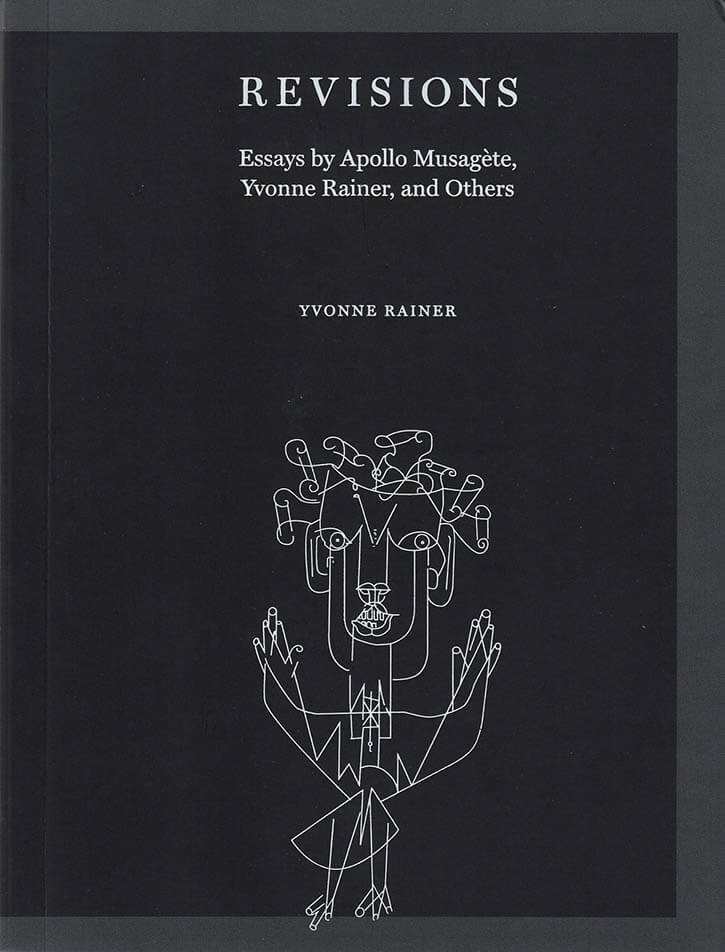
Revisions
The final iteration of Rainer's dance rant A Truncated History of the Universe for Dummies, accompanied by texts offering a real-time account of Rainer's creative process.
Choreographer and filmmaker Yvonne Rainer has long investigated the ways in which movement can be a political act in and of itself—on the stage, on the screen, or at the lectern. In Revisions, Rainer pushes her interest in embodied activism to a new arena: what she calls the “dance rant.” This volume includes the final iteration of Rainer's latest dance rant, entitled A Truncated History of the Universe for Dummies. This performance piece evolved in live presentations in Dublin, Stockholm, and New York before being expanded and adapted in written form here. In this now-completed work, Rainer mobilizes her rage and bafflement at contemporary political events through the guise of Apollo, Leader of the Muses.
Revisions also includes a compilation of emails and diary entries that provide a real-time account of Rainer's process of creating and workshopping a dance. “Pedagogical Vaudeville 3” reveals Rainer's consistent interest in reworking and reconsidering material across multiple mediums, formats, and contexts, and offers a unique glimpse at the working methods of one of this century's preeminent dance artists.
Bookended with an introduction by artist and scholar Gregg Bordowitz and an analysis of Rainer's AG Indexical with a Little Help from H. M. by dance historian Anna Staniczenko, these texts serve not only as a revision of the conventional understanding of five decades of Rainer's production, but also as a timely manual for performance as an act of resistance.

Thresholes
THRESHOLES is both a doorway and an absence, a road map and a remembering. In this almanac of place and memory, Lara Mimosa Montes explores the passage of time, returning to the Bronx of the ’70s and ’80s and the artistry that flourished there. What is the threshold between now and then, and how can the poet be the bridge between the two? Just as artists of that time highlighted what was missing in the Bronx, this collection examines what is left open in the wake of trauma and loss.
Lara Mimosa Montes is a writer based in Minneapolis and New York. Her poems and essays have appeared in Academy of American Poets’ Poem-A-Day, BOMB, Boston Review, Hyperallergic, Jacket2, and elsewhere. She is a 2018 McKnight Writing Fellow and CantoMundo Fellow. She holds a PhD in English from The Graduate Center, City University of New York. Currently, she works as a senior editor of Triple Canopy. She was born in the Bronx.

Nicole Eisenman
Clotilde Viannay, Nicole Eisenman
L'Incroyable is a monographic magazine dedicated to an artist's teenage years and his cultural background. This third issue proposes an immersion into the young years of artist Nicole Eisenman in New York in the 1980s.
Founded in 2015 by artist Clotilde Viannay, L'Incroyable magazine is dedicated to adolescence and retraces the teenage years of a personality, examining the cultural context of his youth.
The magazine is extended by the “Mini” series. Each book immerses itself in the youth of artists through an interview about their teenage years.
Since the 1990s the American artist Nicole Eisenman (born 1965 in Verdun, France, lives and works in New York) has garnered attention with her figurative paintings that, playfully and with great artistic freedom, cross stylistic and compositional elements from the history of art from Renaissance painting to modernism with comics, slapstick, TV culture, pornography, and subcultural image strategies.
Central to Eisenman's oeuvre is a complex, excessive, drawing-based work that comprises all the classical picture genres as well as a wit formulated between the outrageous and the idiotic. Nicole Eisenman's work is an inspired and gleeful deconstruction of conventions in art and society and it questions social models above all by reversing the clichés of female and male roles. It is about power and powerlessness, about art and commerce, consumerism and sex, about the possibilities made available by professionalism and dilettantism, and how artistic success and everyday life are constructed.
At the same time her work deals with the subsequent question of how the individual and she herself as artist and woman can take up a position within these roles. Eisenman's narratives of grotesque reformulations of social orders, or her depictions of human individuality, are always interspersed with possible failure or scenic breakdown: the pictorial content, the painting procedure, and the message contradict each other, and investigate a state of decline in historical as well as current conventions.
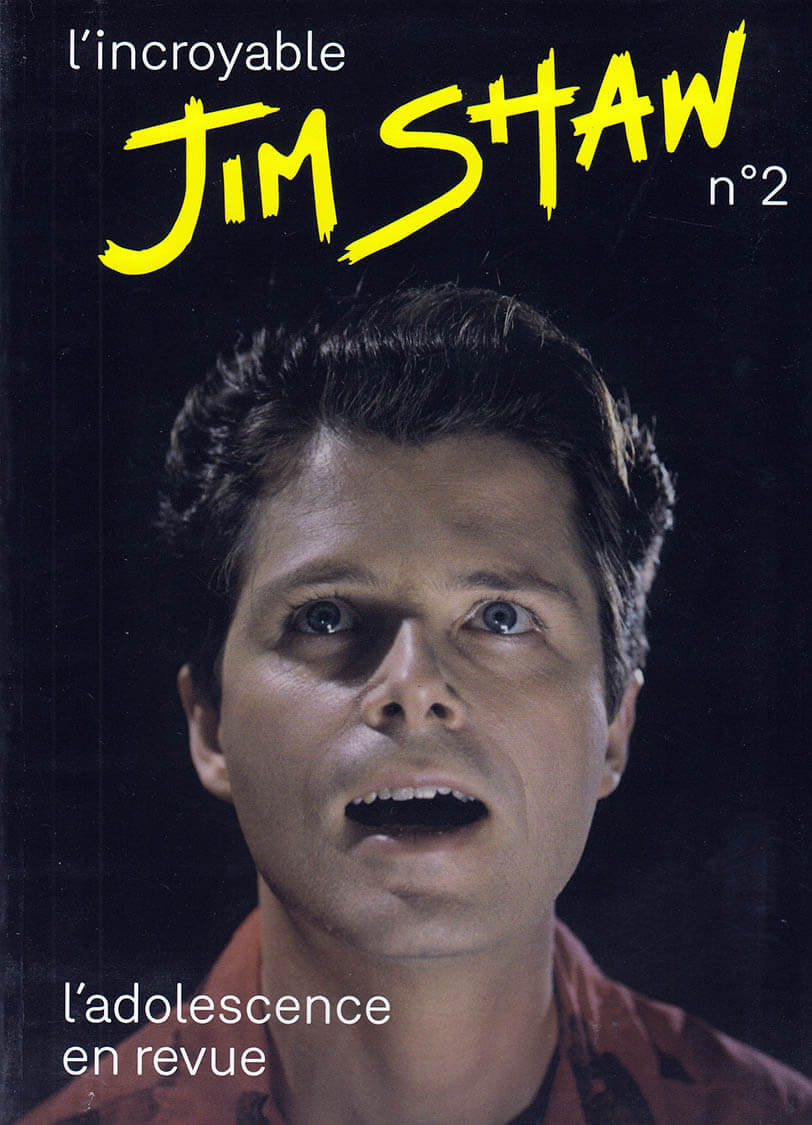
Jim Shaw
L'Incroyable is a monographic magazine dedicated to an artist's teenage years and his cultural background. This second issue focuses on Jim Shaw's Californian youth between the late 1950s and the beginning of the 1970s.
34 contributors—including Jim Shaw, Tony Oursler and Cary Loren—discuss childhood, adolescence, being a student in California in the 1970s, Mike Kelley, comic books, drawing, painting, California, the hippies, LSD, Charles Manson, the Vietnam War, Richard Nixon, My Mirage and Oism, Born Again Christians, catechism, transhumanism, cyborgs, Scientology and the Church of Satan, Terrence Malick, the Beat Generation, counter-culture, Gilbert Shelton, Robert Crumb, Janis Joplin and Basil Wolverton, Michigan, Ann Arbor, proto- punk, Destroy All Monsters, MC5, John Sinclair, and Tiki culture.
Works by Mathilde Agius, Joan Braun, Bertrand Dezoteux, Golgotha, groupe CCC – Alice Gavin and Valentin Bigel and École Duperré Paris students, Jérémy Piningre, Jim Shaw, Pierre Vanni.
Founded in 2015 by artist Clotilde Viannay, L'Incroyable magazine is dedicated to adolescence and retraces the teenage years of a personality, examining the cultural context of his youth.
The magazine is extended by the “Mini” series. Each book immerses itself in the youth of artists through an interview about their teenage years.
Jim Shaw (born 1952 in Midland, Michigan, lives and works in Los Angeles) is an atypical figure in the Californian art world, sharing with Paul McCarthy and Mike Kelley a similar desire to produce an immersive visual oeuvre aimed at exploring the dark side of the American psyche.
Texts by Philippe Aronson, Jacques Barbéri and Yves Ramonet, Claire Barliant, Laura Ben Hayoun, Mathieu Buard, Robert Buchard, Laurent Courau, Michel Croce-Spinelli, Michel Parbot, Jill Gasparina, Étienne Greib, Doug Harvey, Yves-Alexandre Jaquier, Cary Loren, Alex Mar, Robert Somma, Philippe Vasset, Clotilde Viannay, interviews with Jim Shaw, Tony Oursler, Cary Loren, Neil Harbisson, Natasha Vita-More, Gilbert Shelton.
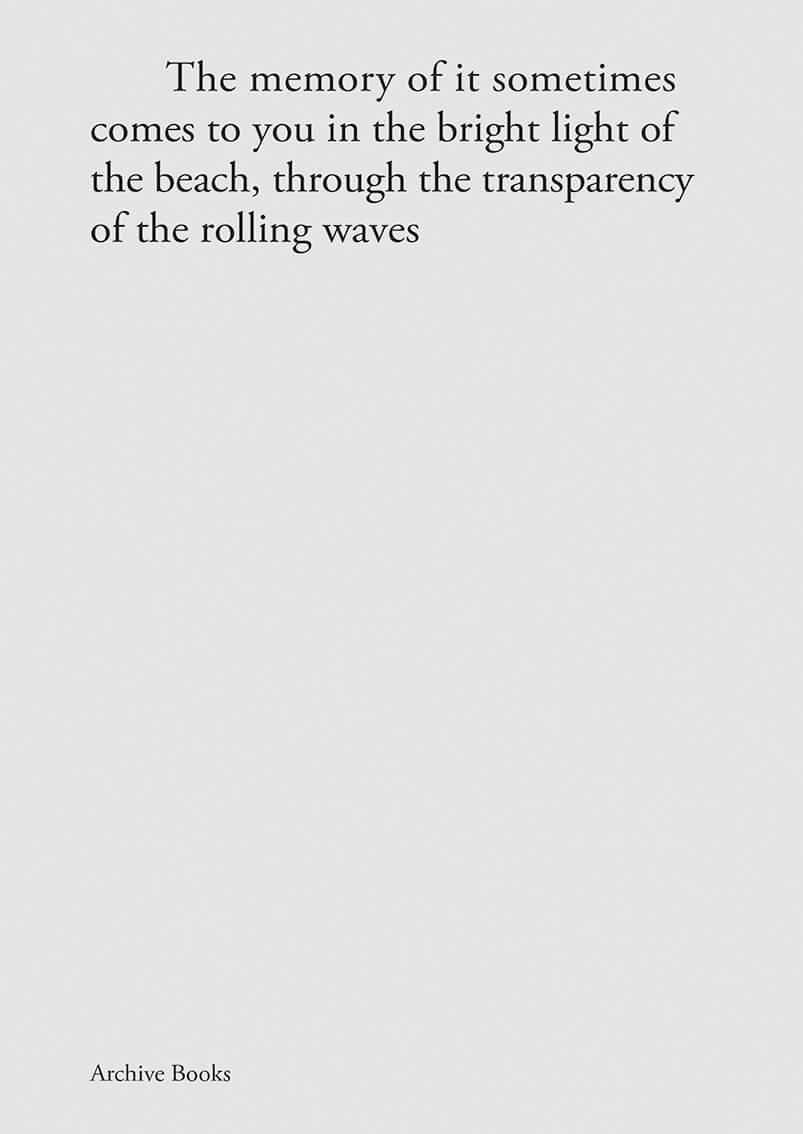
Encircling the Image of Trauma
This book tiptoes between aesthetics and ethics; it proposes to rethink trauma in its necessity as well as impossibility to be represented and understood.
The traumatic experience of violence marks social orders and imbues history. How does it reach beyond distress and pain? This collection of works interrogates alternative narratives: The traces of trauma may also comprise a subversive potential, which withdraws from the hold of power and instead makes room for a sense of history's vulnerability.
Thoughts, artistic contributions and text, most of them produced especially for this volume, move around notions of trauma, in an attempt to encircle moments, at which translation of meaning seems suddenly suspended.
Contributions by Pavel Büchler, Anca Benera & Arnold Estefan, Wendelien van Oldenborgh, Jenny Edkins, Aurélien Gamboni & Sandrine Teixido, Unica Zürn, Falke Pisano, Katja Mater, Georges Perec, Andrea Bellu, Ben Seymour, Natascha Sadr Haghighian, Gitte Villesen.
Published with Centre d'Art Contemporain Genève.
published in March 2020
English edition
13 x 20 cm (softcover)
240 pages (ill.)

Marion Baruch
First comprehensive monograph on Marion Baruch's work. This edition presents a broad span of Baruch's oeuvre, from the 1960s to her recent textile production. It includes three essays—by Fanni Fetzer, Martin Herbert, and Noah Stolz—as well as polyphonic focus texts by curators, friends, and art historians from the artist's circle, all providing compelling insights into her works and methods.
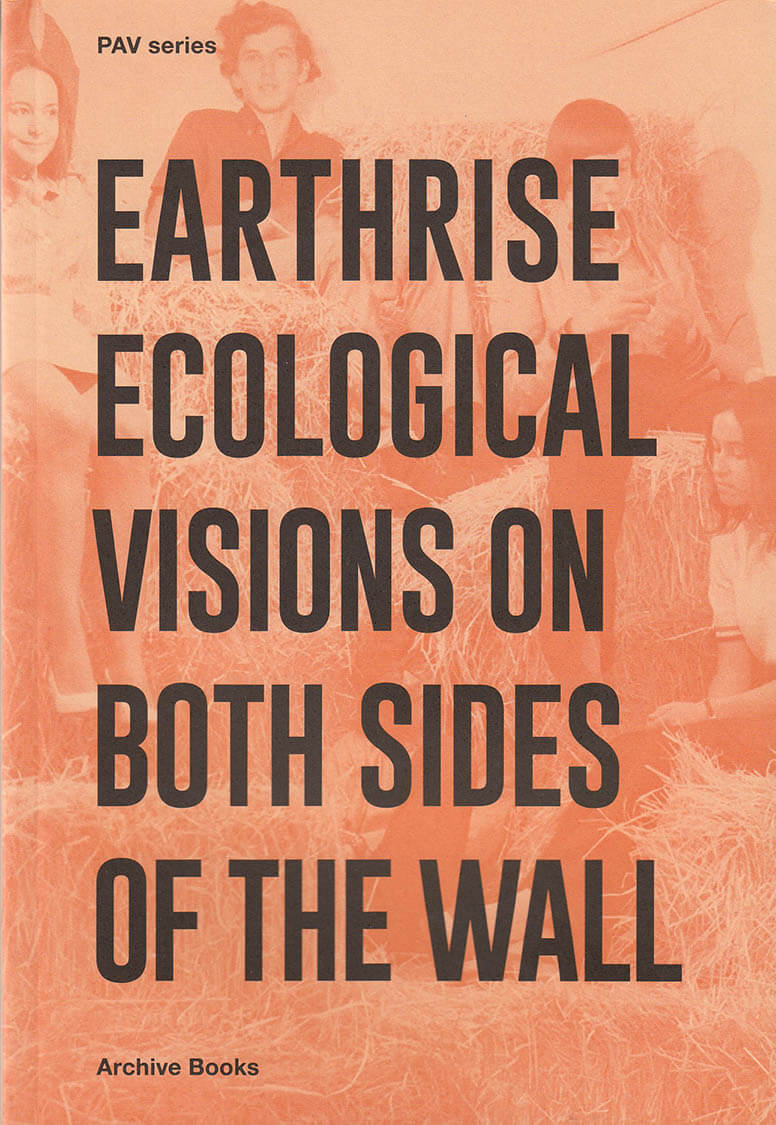
Earthrise
There is no question that ecological ideas acquired a central role in contemporary episteme. In contrast, the heuristic function that these ideas can assume in the current polarisation is questionable: that which, over the last decade, has identified the environmental crisis with the (categorical and totalitarian) concept of the Anthropocene.
Ecological discourse positioned itself inside historically situated trajectories that contributed to the transformation of aesthetical paradigms and political practices. In the scenario that 1968 opened up, the transversal nature of subjectivity allowed it to cover different fields, beginning with the tension between the logic of a unitary discourse and the creation of a multiplicity of possible worlds, between the molar and the molecular, the micro and the macro.
Ecological thought, as such, cannot help but conflict with that which is assumed to be homogeneous and constant, with that which forces the earth to be centred, measured, and expropriated, just as life must be biogenetically controlled, colonised, and subjected to patriarchy.

Ventoline #1 – été 2020
Ventoline est un fanzine né à la fois d’un enthousiasme quotidien pour ce qui se rapporte à la musique, et d’une véritable lassitude face à la quasi-absence de paroles féminines autour de ce vaste sujet. Commenter, critiquer, prescrire, partager ses histoires, ses goûts, ses dégoûts, en somme, sa culture musicale…
Pourquoi si peu de femmes s’autorisent à le faire? Même lorsqu’elles programment, organisent, sonorisent des concerts, lorsqu’elles mixent tous les week-ends, pogotent au premier rang, lorsqu’elles sortent des disques, dessinent des affiches et récurent les tréfonds de Soulseek. Même lorsqu’elles produisent et consomment de la musique.
Le but de ce fanzine ne sera ni d’émettre des classements, ni de théoriser savamment afin d’être prises au sérieux. La musique nous a construites personnellement et socialement, il s’agira donc de partager nos expériences liées à elle —heureuses comme foireuses—, nos observations, nos fantasmes, nos figures tutélaires.
Ce que ça fait, entre autres, de tourner pendant un mois dans un van, de passer pour la potiche de service ou de se prendre une claque au détour d’une compile. De Portland à Barcelone, en passant par Paris, Marseille, Bruxelles, Lyon et Leipzig, une douzaine de mélomanes polymorphes ont prêté leur voix à ce premier numéro de Ventoline.
(ENG)
Ventoline is a French music zine written and illustrated by women only. The first issue includes contributions by Camille Potte, Louise Bouchu, Anouck Eychenne, Leslie Chanel, Marouchka Payen, Diane Malatesta, Maïssa Daoudi, Hélène Degand, Sarah-Louise Barbett, Inès Di Folco, as well as interviews of Cristina Daura and Aubrey Hornor.
17 x 25 cm, 32 pages printed on newspaper
more on https://ventoline.octavie.club

Lez Talk: a collection of black lesbian short fiction
S. Andrea Allen, Lauren Cherelle
A necessary and relevant addition to the Black LGBTQ literary canon, which oftentimes overlooks Black lesbian writing, Lez Talk is a collection of short stories that embraces the fullness of Black lesbian experiences. The contributors operate under the assumption that "lesbian" is not a dirty word, and have written stories that amplify the diversity of Black lesbian lives.
At once provocative, emotional, adventurous, and celebratory, Lez Talk crosses a range of fictional genres, including romance, speculative, and humor. The writers explore new subjects and aspects of their experiences, and affirm their gifts as writers and lesbian women. Beginning with Sheree L. Greer's "I Can't Turn it Off," a short, powerful tale imbued with socio-political undercurrents, the collection also includes work from Claudia Moss, LaToya Hankins, Lauren Cherelle, K.A. Smith, S. Andrea Allen, Faith Mosley, and Eternity Philops.

Girls, Visions and Everything
It's summer in New York City and the streets are sizzling. Below 14th Street the girls at the Kitsch-Inn are hard at work on their new lesbian version of A StreetCar Named Desire. As the temperature rises, lesbian-at-large Lila Futuransky is looking for adventure, with her keys in her pocket and a copy of On The Road in her hand.
A fast-paced, spirited romp through politics and sexuality, Girls, Visions and Everything offers a funny, affectionate portrait of a group of struggling young artists trying to find meaning in their changing world.

exit ambition
Exit Ambition is a catalogue of practices, documents, videos, and other projects - virtual & actual. The book operates as an incomplete index of a series of installations, instructions, anti-plays, performance scores, descriptions, etc.
Jake Reber lives and works in Buffalo, NY, where he co-curates hystericallyreal.com.